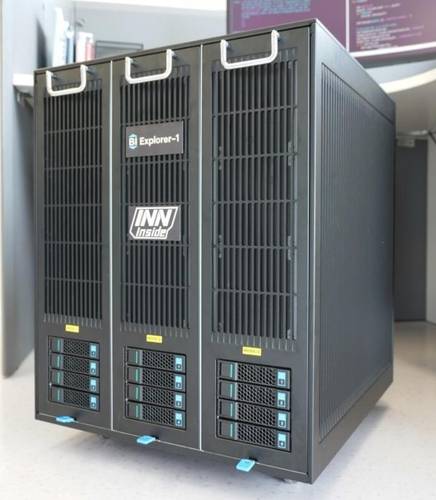
Researchers from China presented a new high-performance equipment that promises combine the power of a supercomputer with the size of a common household appliance. Called BI Explorer — or BIE-1 —, the model is the result of a partnership between two companies incubated in Guangdong Institute of Intelligence Science and Technology (GDIIST).
With dimensions similar to those of a minibar, the BIE-1 can be Connected directly to residential or corporate sockets and stands out for low energy consumptionestimated at just 10% of the expense of conventional supercomputers.
Miniaturization and energy efficiency
According to information released by the responsible laboratories, BIE-1 was developed to bring data center processing power to home and business environments.
Even without all the technical details published, the prototype features impressive specifications:
1,152 CPU cores;
4.8TB of DDR5 memory;
204TB of internal storage;
noise level below 45 decibels;
stable operating temperature below 70°C.
The project is led by companies Zhuhai Hengqin Neogenint Technology e Suiren Medical Technologywho work in partnership within GDIIST. According to the institute, BIE-1 was thought of as a versatile and modular equipmentsuitable for use in different sectorslike home health, personalized education and office automation.
Applications and proposed use
The objective is for the device to function as a smart super assistantcapable of performing complex local computing tasks — without fully relying on external servers or cloud connections.
Among the planned applications are:
continuous monitoring of health parameters in homes;
support personalized virtual tutors for homeschooling;
cognitive assistance in work environments;
use in laboratories and small businesses that require intensive data processing, but with limited space and energy.
The team states that the device can be sold in versions adjusted to the usage profile — from simplified models to more robust corporate configurations.
AI performance and capability
One of the most notable aspects of the BIE-1 is its performance on artificial intelligence (AI) tasks. According to the developers, the system can train 100 thousand tokens per second e perform inferences of up to 500 thousand tokens per second em large language models — performance equivalent to that of servers equipped with multiple GPUs.
This means that BIE-1 could locally run generative AI systemssuch as conversational assistants, neural translators and image analysis tools, without relying on large cloud infrastructures.
Power, according to the creators, is achieved thanks to a “intuitive neural network” developed in-housewhich mimics the processing mechanisms of the human brain. This architecture allows the system learn from small amounts of data e extract complex patterns quickly.
Intuitive neural network: the secret of the project
According to the Neogenint ea Suiren Medicalthe core technology of the BIE-1 is a proprietary bio-inspired neural networkdesigned for work with multiple modalities of data — text, image and speech — in the same model.
Unlike traditional AI architectures based on massive statistical calculations, BIE-1’s intuitive network seeks simulate human cognitive processesmaking the machine’s reasoning more explainable.
The researchers highlight that the system is transparentallowing visualize reasoning and argument construction step by stepwhich represents an advance towards a More interpretable and secure AI.
“This ability to show how the system reached a conclusion is a game changer. It is the type of transparency that is missing in many current models”, said one of the GDIIST scientists, during the launch.
Industrial potential and digital autonomy
The launch of BIE-1 takes place in a context of China’s strong investment in technological autonomy e reduced dependence on foreign chips. The country has sought to develop high performance national hardware capable of sustaining its ambitions in artificial intelligence, quantum computing and supercomputing.
The miniaturization of the BIE-1 could represent a new paradigm for the advanced computing industrybringing the power of supermachines closer to laboratories, companies and even homes.
Experts say the project reflects China’s strategy of “democratize supercalculation”decentralizing access to processing capacity.
“If the promised performance is confirmed, the BIE-1 opens a new category of devices: personal supercomputers”, assessed the technology analyst Zhang Leifrom the magazine TechChina.
Challenges and next steps
Despite the enthusiasm, the laboratory still did not present the equipment in operation nor revealed details about commercial availability or cost. There is also no information about the type of processors used — whether they are proprietary chips or optimized versions of known architectures, such as ARM or RISC-V.
Analysts point out that the biggest challenge will balance high performance, cooling and energy efficiency in such a compact format.
Still, the project is already awakening international interest. Universities and research centers in Europe and Asia expressed their intention to test the platform, especially in AI applied to healthcare, robotics and educational automation.
Desktop supercomputing
With the BI ExplorerChina enters new technological territory, combining supercomputing, artificial intelligence and compact design.
If the advertised performance and efficiency are confirmed, the BIE-1 could redefine the concept of personal supercomputerbringing capabilities hitherto restricted to large research centers into everyday life — and reinforcing China’s position in the global race for affordable and intelligent high-performance computing.
Source: https://www.ocafezinho.com/2025/10/28/china-revela-supercomputador-do-tamanho-de-um-frigobar-que-promete-revolucionar-a-computacao-domestica/

